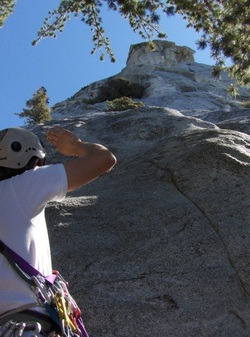Trad Climbing Techniques
 Looking up at Trader Horn, Tahquitz Rock, CA
For many climbers, traditional (trad) climbing is the be all, end all in climbing. It is pure and clean and requires not only skill and athleticism, but also a deep understanding of your equipment and the sport. A trad climber sees beauty in simple lines and complex rock forms, establishing a deep connection with the rock as they peruse every inch in search of a very specific set of conditions that will accept "pro," or protection. There are few things in the world like sitting halfway up a multi-pitch route, secured by your own wits and equipment, and taking in the fall colors, knowing your skills are what got you there and they are going to take you the rest of the way up that splitter crack directly overhead.
If you think trad climbing might be for you, check out our sections here on Cleaning a Trad Route, Building a Rack, and Knots for Trad. If you are just getting started climbing trad and need to know about the basics, look at our articles on Placing Pro (Active, Passive and Natural), Setting a Trad Anchor, Setting a Multi-pitch Anchor, Rope Drag, and Rope Management. Finally, check out our more advanced and specialized articles in Other Traditional Stuff, such as Emergency and Rescue Techniques, Dealing with Personal Issues, and a guide of What to Pack on a long multi-pitch route. |
(Click on a link below or use the toolbar above to navigate)
|
